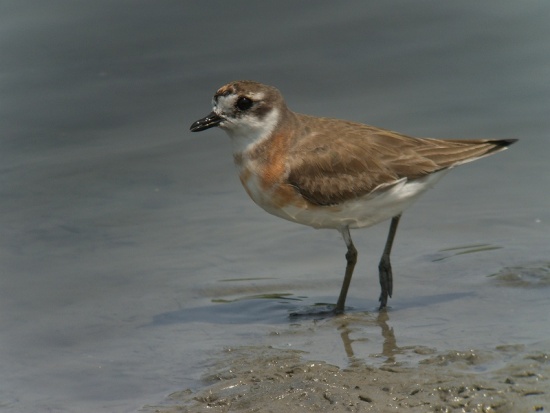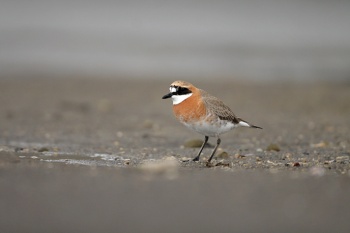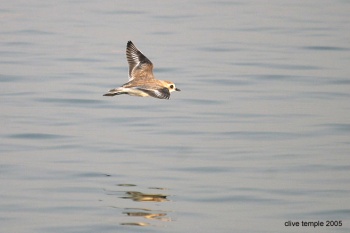(References updated) |
(References updated. Picture placement) |
||
| Line 3: | Line 3: | ||
;[[:Category:Charadrius|Charadrius]] mongolus | ;[[:Category:Charadrius|Charadrius]] mongolus | ||
==Identification== | ==Identification== | ||
| + | [[Image:Gravelot mongol 070507-3240.jpg|thumb|350px|right|Breeding plumage<br />Photo by {{user|Francksan|Francksan}}<br />Hokkaido, [[Japan]], May 2007 ]] | ||
18–21 cm (7-8¼ in) | 18–21 cm (7-8¼ in) | ||
*Grey back | *Grey back | ||
| Line 12: | Line 13: | ||
The female is similar but duller<br /> | The female is similar but duller<br /> | ||
'''Winter and juvenile''' birds lack the chestnut | '''Winter and juvenile''' birds lack the chestnut | ||
| − | + | ||
The two groups mentioned under taxonomy differ in several characters, such that a member of the ''mongolus'' group on average are larger than an ''atrifrons'' sand plover, and ''mongolus'' have mottled flanks where ''atrifrons'' have clean white flanks. | The two groups mentioned under taxonomy differ in several characters, such that a member of the ''mongolus'' group on average are larger than an ''atrifrons'' sand plover, and ''mongolus'' have mottled flanks where ''atrifrons'' have clean white flanks. | ||
====Similar Species==== | ====Similar Species==== | ||
| + | [[Image:13386IMG 8311.jpg|thumb|350px|right|Photo by {{user|Gashead|Gashead}}<br />Dubai, United Arab Emirates,]] | ||
[[Greater Sand Plover]] | [[Greater Sand Plover]] | ||
==Distribution== | ==Distribution== | ||
| Line 21: | Line 23: | ||
==Taxonomy== | ==Taxonomy== | ||
====Subspecies==== | ====Subspecies==== | ||
| + | [[Image:lesser_sand_plover.JPG|thumb|350px|right|Ssp. ''C. m. atrifrons'' : Breeding plumage<br />Photo by {{user|aloktewari|Alok Tewari}}<br />Nazafgarh Marshes, Delhi-Gurgaon Border, [[India]], May-2017]] | ||
| + | [[Image:lesser_sand_plover_alok.JPG|thumb|350px|right|Ssp. ''C. m. pamirensis'' : Non-breeding plumage<br />Photo by {{user|aloktewari|Alok Tewari}}<br />Jamnagar, Coastal Gujarat, [[India]], Jan-2016]] | ||
There are five races, which fall in two groups<sup>[[#References|[1]]]</sup>: | There are five races, which fall in two groups<sup>[[#References|[1]]]</sup>: | ||
* ''mongulus'' are the large east Asian forms, ''C. m. mongolus'' and ''C. m. stegmanni'' which are sometimes given specific status as Mongolian Plover, ''Charadrius mongolus''. | * ''mongulus'' are the large east Asian forms, ''C. m. mongolus'' and ''C. m. stegmanni'' which are sometimes given specific status as Mongolian Plover, ''Charadrius mongolus''. | ||
* ''atrifrons'' consists of ''atrifrons'', ''pamirensis'' and ''schaeferi'' which, if the taxonomic split is accepted, becomes a narrower Lesser Sandplover ''Charadrius atrifrons''. | * ''atrifrons'' consists of ''atrifrons'', ''pamirensis'' and ''schaeferi'' which, if the taxonomic split is accepted, becomes a narrower Lesser Sandplover ''Charadrius atrifrons''. | ||
| − | |||
*''C. m. pamirensis'': | *''C. m. pamirensis'': | ||
:*Pamirs to western [[China]] (western Xinjiang); winters to [[Africa]] and western [[India]] | :*Pamirs to western [[China]] (western Xinjiang); winters to [[Africa]] and western [[India]] | ||
| Line 36: | Line 39: | ||
:*Kamchatka to Chukotsk Peninsula; winters to [[Australia]] | :*Kamchatka to Chukotsk Peninsula; winters to [[Australia]] | ||
==Habitat== | ==Habitat== | ||
| − | |||
Coastal shores, mudflats and fields | Coastal shores, mudflats and fields | ||
==Behaviour== | ==Behaviour== | ||
| Line 46: | Line 48: | ||
'''Flight call''': A hard trill. | '''Flight call''': A hard trill. | ||
==References== | ==References== | ||
| − | + | #{{Ref-Clements6thAug17}}#Collins Bird Guide ISBN 0 00 219728 6 | |
| − | #{{Ref- | ||
#Wikipedia | #Wikipedia | ||
#[http://www.birdforum.net/showthread.php?t=151101 Thread] in Birdforum Id forum discussing Lesser vs Greater Sand Plover identification | #[http://www.birdforum.net/showthread.php?t=151101 Thread] in Birdforum Id forum discussing Lesser vs Greater Sand Plover identification | ||
Revision as of 00:59, 6 December 2017
Alternative name: Mongolian Plover
- Charadrius mongolus
Identification
18–21 cm (7-8¼ in)
- Grey back
- White underparts
- Legs are dark and the bill black
Breeding
- Chestnut breast, forehead and nape
- Black eye mask
The female is similar but duller
Winter and juvenile birds lack the chestnut
The two groups mentioned under taxonomy differ in several characters, such that a member of the mongolus group on average are larger than an atrifrons sand plover, and mongolus have mottled flanks where atrifrons have clean white flanks.
Similar Species
Distribution
Breeds in northern Asia. Winters in south Asia, Africa and Australia.
Vagrants have been recorded in Europe and America.
Taxonomy
Subspecies
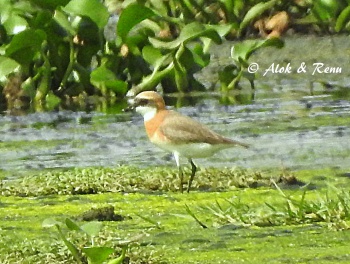
Photo by Alok Tewari
Nazafgarh Marshes, Delhi-Gurgaon Border, India, May-2017
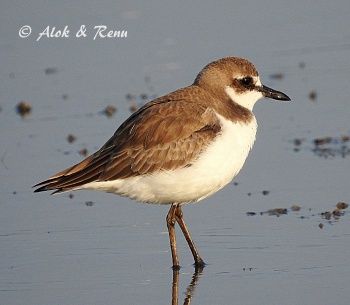
Photo by Alok Tewari
Jamnagar, Coastal Gujarat, India, Jan-2016
There are five races, which fall in two groups[1]:
- mongulus are the large east Asian forms, C. m. mongolus and C. m. stegmanni which are sometimes given specific status as Mongolian Plover, Charadrius mongolus.
- atrifrons consists of atrifrons, pamirensis and schaeferi which, if the taxonomic split is accepted, becomes a narrower Lesser Sandplover Charadrius atrifrons.
- C. m. pamirensis:
- C. m. atrifrons:
- C. m. schaeferi:
- Eastern Tibet to southern Mongolia; winters Thailand to Greater Sundas
- C. m. mongolus:
- Eastern Siberia and Russian Far East; winters Taiwan to Australia
- C. m. stegmanni:
- Kamchatka to Chukotsk Peninsula; winters to Australia
Habitat
Coastal shores, mudflats and fields
Behaviour
Breeding
It nests in a bare ground scrape, laying 3 eggs.
Diet
Diet includes insects, crustaceans and annelid worms.
Vocalisation
Flight call: A hard trill.
References
- Clements, J. F., T. S. Schulenberg, M. J. Iliff, D. Roberson, T. A. Fredericks, B. L. Sullivan, and C. L. Wood. 2017. The eBird/Clements checklist of birds of the world: v2017, with updates to August 2017. Downloaded from http://www.birds.cornell.edu/clementschecklist/download/
- Collins Bird Guide ISBN 0 00 219728 6
- Wikipedia
- Thread in Birdforum Id forum discussing Lesser vs Greater Sand Plover identification
Recommended Citation
- BirdForum Opus contributors. (2024) Siberian Sand Plover. In: BirdForum, the forum for wild birds and birding. Retrieved 25 April 2024 from https://www.birdforum.net/opus/Siberian_Sand_Plover
External Links




